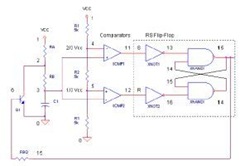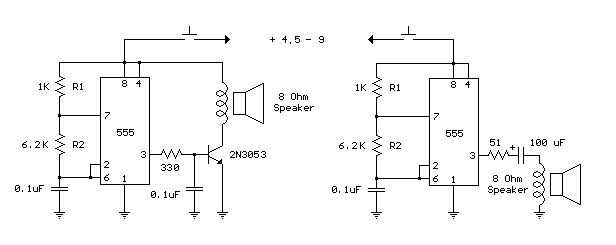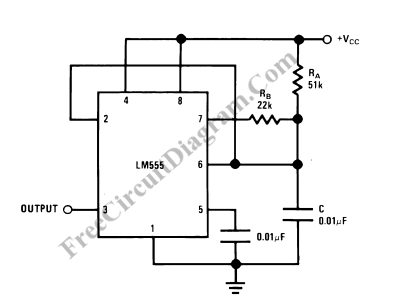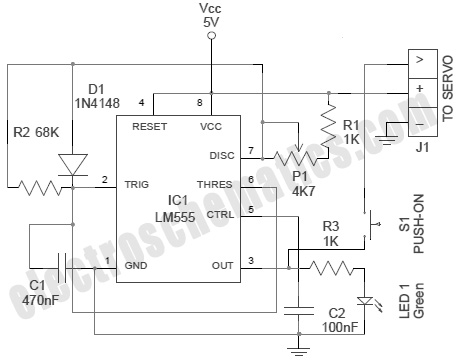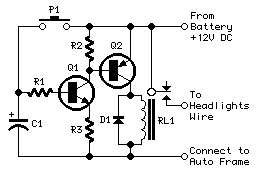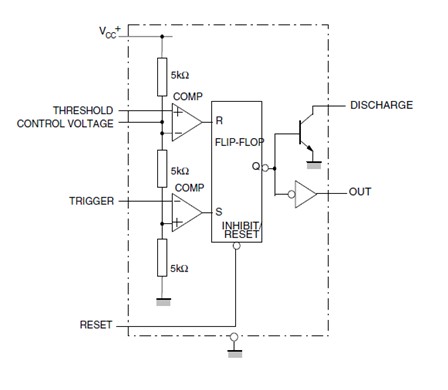
555 timer

The 555 timer IC was first introduced around 1971 by the Signetics Corporation as the SE555/NE555 and was referred to as "The IC Time Machine." It was the first commercially available timer IC, providing circuit designers and hobbyists with an affordable, stable, and user-friendly integrated circuit for both monostable and astable applications. Since its introduction, numerous unique circuits have been developed and documented in various trade, professional, and hobby publications. Over the past decade, some manufacturers have ceased production of these timers due to competition or other reasons, while others, such as NTE (a subsidiary of Philips), have continued to produce them. This primer discusses the enduring popularity of the 555 timer, which remains widely used in many schematics even after 30 years. Although CMOS versions like the Motorola MC1455 have become more prevalent, the standard type is still available, albeit with various improvements and variations in circuitry. All types maintain pin-for-pin compatibility. The 555 timer consists of a complex arrangement of transistors, diodes, and resistors, which will be explained through a simplified block diagram in this tutorial. The 555 timer is available in two packages: the round metal-can, known as the 'T' package, and the more common 8-pin DIP 'V' package. The 556 timer is a dual version of the 555, housed in a 14-pin DIP package, while the 558 is a quad version with four 555 timers, also in a 14-pin DIP case. The internal structure of the 555 timer includes over 20 transistors, 15 resistors, and 2 diodes, depending on the manufacturer. The equivalent block diagram illustrates functions such as control, triggering, level sensing or comparison, discharge, and power output. Notable features of the 555 timer include a supply voltage range of 4.5 to 18 volts, a supply current of 3 to 6 mA, and a rise/fall time of 100 ns. The device can endure significant abuse, with a typical supply current of 1 mA or less when the output is high. The initial monostable timing accuracy is typically within 1% of the calculated value, with negligible drift (0.1%/V) concerning supply voltage, allowing long-term supply variations to be disregarded. Temperature variation is limited to 50 ppm/°C (0.005%/°C). All IC timers require an external capacitor to determine the off-on time intervals of the output pulses. As established in basic electronics, a capacitor (C) takes a finite period to charge or discharge through a resistor (R). These time intervals can be calculated based on the values of resistance and capacitance. The basic RC charging circuit demonstrates this principle, where a capacitor begins to charge through a resistor when a switch is closed, causing the voltage across the capacitor to rise from zero to the applied DC voltage. The charge curve for this circuit can be illustrated, showing that the time taken for the capacitor to charge to approximately 63.7% of the applied voltage is known as the time constant (t), calculable by a simple expression. For example, if the applied voltage is 6 volts, it will take one time constant for the voltage across the capacitor to reach about 63.2% of the applied voltage.
The 555 timer IC is a versatile and widely utilized component in electronic circuits, serving various applications including timers, oscillators, and pulse-width modulation. Its internal architecture is designed to facilitate both monostable and astable operation modes. In monostable mode, the 555 timer generates a single output pulse in response to a triggering event, while in astable mode, it produces a continuous square wave output, with the frequency and duty cycle determined by external resistors and capacitors.
The standard pin configuration of the 555 timer includes pins for power supply, ground, trigger, threshold, discharge, output, reset, and control voltage. The trigger pin initiates the timing cycle, while the threshold pin detects when the capacitor voltage reaches a specific level to reset the timer. The discharge pin is connected to the timing capacitor, allowing it to discharge when the timing cycle completes. The output pin provides the timer's signal, which can drive various loads depending on the application.
In practical applications, the 555 timer can be employed in blinking LED circuits, tone generation, frequency modulation, and even simple motor control. Its resilience to voltage fluctuations and temperature variations makes it suitable for use in various environments. The ability to operate at different supply voltages and the availability of multiple package types further enhance its usability in diverse electronic projects. As a fundamental building block in electronics, the 555 timer continues to inspire innovation and creativity among engineers and hobbyists alike.The 555 timer IC was first introduced around 1971 by the Signetics Corporation as the SE555/NE555 and was called "The IC Time Machine" and was also the very first and only commercial timer ic available. It provided circuit designers and hobby tinkerers with a relatively cheap, stable, and user-friendly integrated circuit for both monostable and as
table applications. Since this device was first made commercially available, a myrad of novel and unique circuits have been developed and presented in several trade, professional, and hobby publications. The past ten years some manufacturers stopped making these timers because of competition or other reasons.
Yet other companies, like NTE (a subdivision of Philips) picked up where some left off. This primer is about this fantastic timer which is after 30 years still very popular and used in many schematics. Although these days the CMOS version of this IC, like the Motorola MC1455, is mostly used, the regular type is still available, however there have been many improvements and variations in the circuitry.
But all types are pin-for-pin plug compatible. Myself, every time I see this 555 timer used in advanced and high-tech electronic circuits, I`m amazed. It is just incredible. In this tutorial I will show you what exactly the 555 timer is and how to properly use it by itself or in combination with other solid state devices without the requirement of an engineering degree.
This timer uses a maze of transistors, diodes and resistors and for this complex reason I will use a more simplified (but accurate) block diagram to explain the internal organizations of the 555. So, lets start slowly and build it up from there. The 555, in fig. 1 and fig. 2 above, come in two packages, either the round metal-can called the `T` package or the more familiar 8-pin DIP `V` package.
About 20-years ago the metal-can type was pretty much the standard (SE/NE types). The 556 timer is a dual 555 version and comes in a 14-pin DIP package, the 558 is a quad version with four 555`s also in a 14 pin DIP case. I nside the 555 timer, at fig. 3, are the equivalent of over 20 transistors, 15 resistors, and 2 diodes, depending of the manufacturer.
The equivalent circuit, in block diagram, providing the functions of control, triggering, level sensing or comparison, discharge, and power output. Some of the more attractive features of the 555 timer are: Supply voltage between 4. 5 and 18 volt, supply current 3 to 6 mA, and a Rise/Fall time of 100 nSec. It can also withstand quite a bit of abuse. The supply current, when the output is `high`, is typically 1 milli-amp (mA) or less. The initial monostable timing accuracy is typically within 1% of its calculated value, and exhibits negligible (0.
1%/V) drift with supply voltage. Thus longterm supply variations can be ignored, and the temperature variation is only 50ppm/ °C (0. 005%/ °C). All IC timers rely upon an external capacitor to determine the off-on time intervals of the output pulses. As you recall from your study of basic electronics, it takes a finite period of time for a capacitor (C) to charge or discharge through a resistor (R).
Those times are clearly defined and can be calculated given the values of resistance and capacitance. The basic RC charging circuit is shown in fig. 4. Assume that the capacitor is initially discharged. When the switch is closed, the capacitor begins to charge through the resistor. The voltage across the capacitor rises from zero up to the value of the applied DC voltage. The charge curve for the circuit is shown in fig. 6. The time that it takes for the capacitor to charge to 63. 7% of the applied voltage is known as the time constant (t). That time can be calculated with the simple expression: Assume further that the applied voltage is 6 volts.
That means that it will take one time constant for the voltage across the capacitor to reach 63. 2% of the applied voltage. Theref 🔗 External reference
The 555 timer IC is a versatile and widely utilized component in electronic circuits, serving various applications including timers, oscillators, and pulse-width modulation. Its internal architecture is designed to facilitate both monostable and astable operation modes. In monostable mode, the 555 timer generates a single output pulse in response to a triggering event, while in astable mode, it produces a continuous square wave output, with the frequency and duty cycle determined by external resistors and capacitors.
The standard pin configuration of the 555 timer includes pins for power supply, ground, trigger, threshold, discharge, output, reset, and control voltage. The trigger pin initiates the timing cycle, while the threshold pin detects when the capacitor voltage reaches a specific level to reset the timer. The discharge pin is connected to the timing capacitor, allowing it to discharge when the timing cycle completes. The output pin provides the timer's signal, which can drive various loads depending on the application.
In practical applications, the 555 timer can be employed in blinking LED circuits, tone generation, frequency modulation, and even simple motor control. Its resilience to voltage fluctuations and temperature variations makes it suitable for use in various environments. The ability to operate at different supply voltages and the availability of multiple package types further enhance its usability in diverse electronic projects. As a fundamental building block in electronics, the 555 timer continues to inspire innovation and creativity among engineers and hobbyists alike.The 555 timer IC was first introduced around 1971 by the Signetics Corporation as the SE555/NE555 and was called "The IC Time Machine" and was also the very first and only commercial timer ic available. It provided circuit designers and hobby tinkerers with a relatively cheap, stable, and user-friendly integrated circuit for both monostable and as
table applications. Since this device was first made commercially available, a myrad of novel and unique circuits have been developed and presented in several trade, professional, and hobby publications. The past ten years some manufacturers stopped making these timers because of competition or other reasons.
Yet other companies, like NTE (a subdivision of Philips) picked up where some left off. This primer is about this fantastic timer which is after 30 years still very popular and used in many schematics. Although these days the CMOS version of this IC, like the Motorola MC1455, is mostly used, the regular type is still available, however there have been many improvements and variations in the circuitry.
But all types are pin-for-pin plug compatible. Myself, every time I see this 555 timer used in advanced and high-tech electronic circuits, I`m amazed. It is just incredible. In this tutorial I will show you what exactly the 555 timer is and how to properly use it by itself or in combination with other solid state devices without the requirement of an engineering degree.
This timer uses a maze of transistors, diodes and resistors and for this complex reason I will use a more simplified (but accurate) block diagram to explain the internal organizations of the 555. So, lets start slowly and build it up from there. The 555, in fig. 1 and fig. 2 above, come in two packages, either the round metal-can called the `T` package or the more familiar 8-pin DIP `V` package.
About 20-years ago the metal-can type was pretty much the standard (SE/NE types). The 556 timer is a dual 555 version and comes in a 14-pin DIP package, the 558 is a quad version with four 555`s also in a 14 pin DIP case. I nside the 555 timer, at fig. 3, are the equivalent of over 20 transistors, 15 resistors, and 2 diodes, depending of the manufacturer.
The equivalent circuit, in block diagram, providing the functions of control, triggering, level sensing or comparison, discharge, and power output. Some of the more attractive features of the 555 timer are: Supply voltage between 4. 5 and 18 volt, supply current 3 to 6 mA, and a Rise/Fall time of 100 nSec. It can also withstand quite a bit of abuse. The supply current, when the output is `high`, is typically 1 milli-amp (mA) or less. The initial monostable timing accuracy is typically within 1% of its calculated value, and exhibits negligible (0.
1%/V) drift with supply voltage. Thus longterm supply variations can be ignored, and the temperature variation is only 50ppm/ °C (0. 005%/ °C). All IC timers rely upon an external capacitor to determine the off-on time intervals of the output pulses. As you recall from your study of basic electronics, it takes a finite period of time for a capacitor (C) to charge or discharge through a resistor (R).
Those times are clearly defined and can be calculated given the values of resistance and capacitance. The basic RC charging circuit is shown in fig. 4. Assume that the capacitor is initially discharged. When the switch is closed, the capacitor begins to charge through the resistor. The voltage across the capacitor rises from zero up to the value of the applied DC voltage. The charge curve for the circuit is shown in fig. 6. The time that it takes for the capacitor to charge to 63. 7% of the applied voltage is known as the time constant (t). That time can be calculated with the simple expression: Assume further that the applied voltage is 6 volts.
That means that it will take one time constant for the voltage across the capacitor to reach 63. 2% of the applied voltage. Theref 🔗 External reference
Warning: include(partials/cookie-banner.php): Failed to open stream: Permission denied in /var/www/html/nextgr/view-circuit.php on line 713
Warning: include(): Failed opening 'partials/cookie-banner.php' for inclusion (include_path='.:/usr/share/php') in /var/www/html/nextgr/view-circuit.php on line 713
